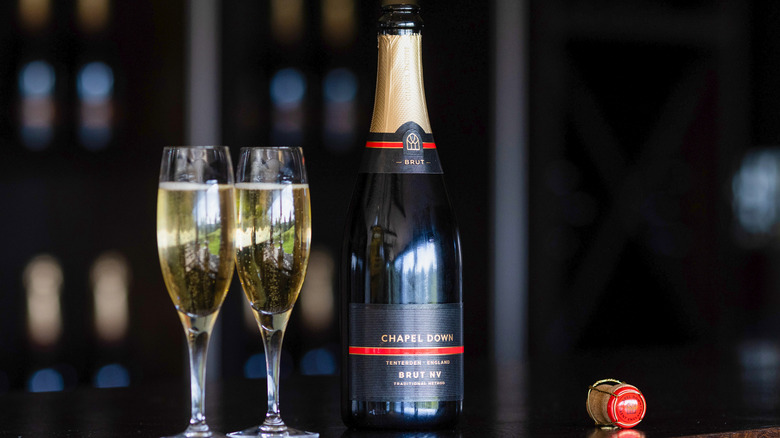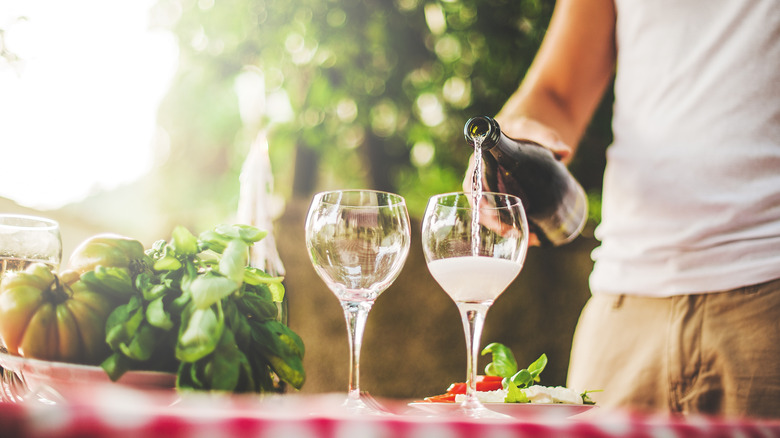The Science Behind Why Champagne Bubbles Rise Straight To The Top
We need to raise a glass to the scientists who have solved a rather niche question: Why do bubbles in champagne go straight to the top in a single file, while bubbles in other carbonated drinks veer off to the sides?
We have collectively seen glimpses of this, like when we order different drinks at a bar and notice how the bubbles in champagne, sparkling water, sparkling wine, and coke are swirling at different speeds and shapes in their respective containers, or at an F1 podium when a driver pops open a celebratory bottle of champagne and it sprays everywhere at jet speed (or to be more specific, 30 miles per hour). There is probably a good reason why they are not spraying cans of beer or even bottles of soda to emulate the sight (and taste) of victory.
But it took researchers at Brown University to tell us the answer: The bubble chains in champagne (and sparkling wines) can form a stable chain thanks to soap-like compounds called surfactants, which reduce the tension between the drink and the bubbles. This creates a clear, friction-free path for the bubbles to rise.
The bubbles are a byproduct of fermentation
To better understand this scientific outcome, perhaps it is good to brush up on why there are bubbles in sparkling wines in the first place. This fizz is more technically known as effervescence and it complements the sensory experience of sparkling wine in the same way a soda stream changes the texture of tap water.
Take champagne, which is typically made from a blend of three grape varieties: chardonnay, pinot noir, and pinot meunier. The wine is fermented in the bottle with yeast and sugar, creating carbon dioxide gas as a byproduct. The pressure inside the bottle then builds up, causing the gas to dissolve into the liquid, forming buoyant bubbles. The type and amount of bubbles differ in each bottle of sparkling wine and are a function of how long and in what way it was fermented. For example, the bubbles in prosecco are lighter and bouncier than those in champagne because the fermentation process for prosecco is shorter and is done in tanks rather than the individual bottles of champagne.
We may also notice how bubbles rise in sparkling wine because of the glassware used to serve it. The traditional champagne flute is tall and narrow, with a tapered opening. This shape means the surface area at the top of the flute is reduced, which helps the bubbles last longer.
The bigger the bubbles, the more likely it is to rise
Back to the research on bubbles, there is more good news. The compounds that act as surfactants to stabilize the chain of bubbles are also what give the drink flavor and a certain "je ne sais quoi" taste, as the French might say. In comparison, sparkling water has no surfactants, which is why the bubbles do not consistently rise to the top. Instead, it dissolves mid-way or slides sideways.
There are other factors that help stabilize the chain of bubbles and guarantee their ascendance, including the size of the bubbles. The larger the bubbles, the higher their chance to effortlessly rise. But do not go out and buy sparkling wine on this basis alone, because the experts cannot agree if the size of the bubbles has any correlation with taste and flavor.
This research on bubbles in drinks may be related to gastronomy but its application is wide-ranging. Now that we understand the way bubbles move and why, it can be applied to anything that involves mixing gas and liquid, such as aeration tanks at water treatment facilities. So the next time you order a glass of champagne, you can also toast to science.


